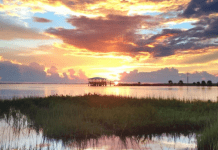In the course of its colorful history, ownership of San Antonio has been claimed by six different governments. Thus, the city is said to have been “under 6 flags.” Rule by France, Spain, Mexico, the Republic of Texas, the Confederate States of America and the United States of America has shaped San Antonio, as each culture has left its mark. Art, architecture, and history intermingle everywhere in this robust southwestern city. With nearly 300 years as a cultural crossroads the city has a colorful past and takes every opportunity to celebrate it! San Antonio is well known as a party going city. Fiestas and festivals abound.
Downtown San Antonio retains an Old World feeling as narrow streets, plazas, and Spanish architecture blend with modern skyscrapers. The city has always been a crossroads and a meeting place. Sounds and flavors of Native America, Old Mexico, Germany, the Wild West, African-America and the Deep South mingle and merge. Close to seven million visitors delight each year in the discovery of San Antonio’s charms.
San Antonio lies on the edge of the Texas Hill country, considered by many to be the most scenic area in the state. Its rolling terrain is dotted with dark green cedars and oaks gradually giving way to prickly pear and cactus. Clear rivers run beneath limestone cliffs and canyons, and spectacular views span the endless blue of the Texas sky.
Much of San Antonio can be explored on foot, although some of its attractions will require transportation. For the Hill Country, a car is a must. You can visit several towns in a day, enjoying some of the landscapes in between as you drive.
Are you looking for excellent traditional jazz or a sing-along at an Irish pub or piano bar? What about Hard Rock Cafe or Planet Hollywood on the River Walk, or Sunset Station? San Antonio offers a wide range of entertainment options both during the day and after the sun goes down. When the stars come out over the South Texas plains, it’s time to head to the nightclubs and dance halls, two-stepping to a country-western band, getting down to a rocking beat or swaying in a slower Tejano style.
San Antonio is a Mecca for history buffs. Native Americans first lived along the San Antonio River, calling the area “Yanaguana,” which means “refreshing waters.” In 1718, at an Cohuiltecan Indian village in a pleasant wooded area of spring-fed streams at the southern edge of the Texas Hill Country, Spanish Friar Antonio Olivares established Mission San Antonio de Valero (later called the Alamo). A customary accompanying presidio (fort), was added in the same year.
This site became permanently etched in the annals of history in 1836 as “The Alamo”, where 189 volunteer freedom fighters died after holding the old mission against some 4,000 Mexican troops for 13 days. The cry “Remember the Alamo” became the rallying point of the Texan revolution against Mexico. Located in the heart of downtown, today The Alamo still stands, dwarfed by twentieth century buildings, as a shrine and museum.
There was a time when flooding occurred on a regular basis with devastating results. After the 1921 flood, there was much deliberation as to how to improve the situation in the future. The fortunate decision was made to construct a bypass channel and two dams to control flooding. The river area was cleaned up, and a footpath and parks were created bordering the river. The result is that the river has become one of the city’s premiere assets, the Riverwalk, which symbolizes beauty and romance instead of destruction.
The Riverwalk is a 2.5 mile (21 block) tree lined promenade where luxury hotels, specialty shops, and European-style cafés line the banks of the San Antonio River . Below street level, the walk is reached by steps from various spots along the main roads and crossed by humpbacked stone bridges. Cobbled paths, lined with tropical plants and shaded by pine, cypress, oak and willow, wind beside the jade-green water, with much of the city’s eating and entertainment concentrated along the way. You can catch a river taxi at various points, or just stroll along and watch.
Dining options in San Antonio run the gamut from fine French cuisine to Chinese to Soul food and Cajun, but the one not to miss is Tex-Mex. Tex-Mex is a passion with local residents of all ethnic backgrounds, and numerous restaurants are open 24 hours.
San Antonio also offers a wide variety of spectator sports – the San Antonio Spurs, San Antonio Dragons of the International Hockey League and the San Antonio Missions minor league baseball team all attract crowds.
The downtown All Around Playground at HemisFair Park and the newly renovated Milam Park across from Market Square provide excellent stops for children to burn off excess energy. The Tower of the Americas offers a spectacular view of San Antonio from 579 feet above the ground.
Among the museums in HemisFair Park is the Institute of Texan Cultures. Articles representative of the social histories of thirty diverse Texan cultures are displayed with especially pertinent African-American and Native American sections. There is even an intriguing corner devoted to short lived attempts to introduce the camel to West Texas as a beast of burden.
West of the river stands the majestic 1731 San Fernando Cathedral, oldest in the US. Mariachi Masses are held on Sunday at 9am and 12.15pm, and crowds spill outside onto the plaza.
Two blocks west on the Plaza de Armas, stands the beautifully simple, whitewashed Spanish Governors Palace which was home to Spanish officials during the mission era. Just one story tall, it doesn’t fit the usual image of a palace, but its flagstone floors, low doorways, beamed ceilings, religious icons and ornate wooden carvings elevate it to that category. It provides an illuminating glimpse of the lifestyles of the civil and religious authorities in this remote outpost. It is easy to imagine them strolling through the cobbled courtyard, with its fountain, mosaic floor and lush palms.
The possibilities for entertainment, cultural offerings, spirited festivals, interesting shopping and exploration of natural wonders are all awaiting the visitor to San Antonio. Whatever your vacation dreams, they will be fulfilled in a visit to this welcoming, exciting, family friendly city.
The site that was to become San Antonio was originally a Coahuiltecan Indian village inhabited by a peaceful nomadic tribe. Spanish clergy seeking to extend their country’s efforts to colonize North America, taught these original inhabitants farming and in the process set up an outstanding system of irrigation that is still in use in the San Antonio area.
A band of Spanish explorers and missionaries came upon the river in 1691, and because it was the feast day of St. Anthony, they named the river “San Antonio.” A permanent settlement was made in 1718 when the city was officially founded by Friar Antonio de San Buenaventura Olivares, who established the first mission and named it after his patron saint, Saint Anthony. Later that same year, Don Martin de Alarcon , Captain General and Governor of the Province of Texas constructed a military fort (presidio) in order to protect the fledgling settlement.
To populate the colony, the Spanish sent several dozen people from the Canary Islands. Four missions built ,which flourished until 1794 when the attacks by Comanche and Apache tribes weakened them to the point that they could not survive. The missions then became military posts. In 1803 Spanish cavalry from Mexico occupied the original mission and changed its name to Mission del Alamo del Parras.
The city of San Antonio became a part of Mexico after the Mexican Revolution of 1821. Moses Austin, a Missouri pioneer, was the first American to attempt to colonize the frontier. He died before his plan came to fruition but his son Stephen F. Austin received a land grant from the new government and brought 300 Anglo families to settle in Texas in 1821.
By 1836, 3,500 Anglos lived in the city. When General Santa Anna abolished the 1824 Mexican constitution, these Americans, along with many Hispanic Texans, refused to recognize his presidency, an act of defiance that led to the Battle of the Alamo in 1836.
Texas won its independence at the Battle of San Jacinto later that year. In the 1840’s there was a great influx of German settlers whose descendants still add to the city’s cosmopolitan flavor. In 1845 Texas entered the union as the 28th state. Thereafter, Anglos settled the city in greater numbers, and by 1860, San Antonio could claim a population of 8,000.
The beef industry grew after the civil war. A trail was established to drive cattle from San Antonio to Abilene, Kansas. With the arrival of the railroad in 1877, the city was directly linked to new northern markets In the 1870’s new settlers, adventurers and cowboys on long cattle drives made San Antonio a tough, hard drinking , hard fighting, gambling town.
In 1876 Fort Sam Houston was established. San Antonio was also the birthplace of the Rough Riders, a defense group formed after the battleship Maine exploded in Havana Harbor in 1898.
San Antonio gained a small but substantial Asian community long before most other Texas cities when, during the revolution, forces led by Francisco “Pancho” Villa were lynching Chinese merchants in northern Mexico. American General John J. Pershing launched a south of the border hunt for Villa in 1917. Pershing’s mission failed, but he brought the endangered merchants back to San Antonio with him, and they became permanent residents.
World War I brought the opening of two aviation training centers: Brooks Air Force base and Kelly Air Force base. Randolph Air Force Base opened in 1930, followed by Lackland Air Force Base in 1942. The military continues to be a vital economic factor in the city.
Since mission times, the San Antonio River has been the key to the city’s fortunes. Destructive floods in the 1920s, and subsequent oil drilling, reduced its flow, leading to plans to pave the river over. Instead, a careful landscaping plan, started in 1939 by the WPA, created the Paseo del Rio, or River Walk which is now the aesthetic and commercial focus of San Antonio.
The site that was to become San Antonio was originally a Coahuiltecan Indian village inhabited by a peaceful nomadic tribe. Spanish clergy seeking to extend their country’s efforts to colonize North America, taught these original inhabitants farming and in the process set up an outstanding system of irrigation that is still in use in the San Antonio area.
A band of Spanish explorers and missionaries came upon the river in 1691, and because it was the feast day of St. Anthony, they named the river “San Antonio.” A permanent settlement was made in 1718 when the city was officially founded by Friar Antonio de San Buenaventura Olivares, who established the first mission and named it after his patron saint, Saint Anthony. Later that same year, Don Martin de Alarcon , Captain General and Governor of the Province of Texas constructed a military fort (presidio) in order to protect the fledgling settlement.
To populate the colony, the Spanish sent several dozen people from the Canary Islands. Four missions built ,which flourished until 1794 when the attacks by Comanche and Apache tribes weakened them to the point that they could not survive. The missions then became military posts. In 1803 Spanish cavalry from Mexico occupied the original mission and changed its name to Mission del Alamo del Parras.
The city of San Antonio became a part of Mexico after the Mexican Revolution of 1821. Moses Austin, a Missouri pioneer, was the first American to attempt to colonize the frontier. He died before his plan came to fruition but his son Stephen F. Austin received a land grant from the new government and brought 300 Anglo families to settle in Texas in 1821.
By 1836, 3,500 Anglos lived in the city. When General Santa Anna abolished the 1824 Mexican constitution, these Americans, along with many Hispanic Texans, refused to recognize his presidency, an act of defiance that led to the Battle of the Alamo in 1836.
Texas won its independence at the Battle of San Jacinto later that year. In the 1840’s there was a great influx of German settlers whose descendants still add to the city’s cosmopolitan flavor. In 1845 Texas entered the union as the 28th state. Thereafter, Anglos settled the city in greater numbers, and by 1860, San Antonio could claim a population of 8,000.
The beef industry grew after the civil war. A trail was established to drive cattle from San Antonio to Abilene, Kansas. With the arrival of the railroad in 1877, the city was directly linked to new northern markets In the 1870’s new settlers, adventurers and cowboys on long cattle drives made San Antonio a tough, hard drinking , hard fighting, gambling town.
In 1876 Fort Sam Houston was established. San Antonio was also the birthplace of the Rough Riders, a defense group formed after the battleship Maine exploded in Havana Harbor in 1898.
San Antonio gained a small but substantial Asian community long before most other Texas cities when, during the revolution, forces led by Francisco “Pancho” Villa were lynching Chinese merchants in northern Mexico. American General John J. Pershing launched a south of the border hunt for Villa in 1917. Pershing’s mission failed, but he brought the endangered merchants back to San Antonio with him, and they became permanent residents.
World War I brought the opening of two aviation training centers: Brooks Air Force base and Kelly Air Force base. Randolph Air Force Base opened in 1930, followed by Lackland Air Force Base in 1942. The military continues to be a vital economic factor in the city.
Since mission times, the San Antonio River has been the key to the city’s fortunes. Destructive floods in the 1920s, and subsequent oil drilling, reduced its flow, leading to plans to pave the river over. Instead, a careful landscaping plan, started in 1939 by the WPA, created the Paseo del Rio, or River Walk which is now the aesthetic and commercial focus of San Antonio.





